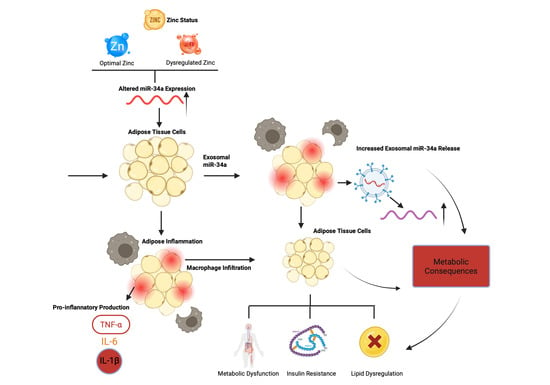Zinc as a Modulator of miRNA Signaling in Obesity
Abstract
1. Introduction
Search Strategy and Study Selection Criteria
2. Zinc in Metabolism and Disease
2.1. Zinc Transport Mechanisms
2.2. Metabolic Functions
3. miRNA Regulation in Obesity
3.1. Key miRNAs and Their Targets
3.2. Expression in Metabolic Disease
4. Zinc-miRNA Interactions
5. Clinical Applications
5.1. Biomarker Development
5.2. Treatment Strategies
6. Future Perspectives
7. Conclusions
Author Contributions
Funding
Institutional Review Board Statement
Informed Consent Statement
Data Availability Statement
Acknowledgments
Conflicts of Interest
Abbreviations
| ATP | Adenosine Triphosphate |
| BMI | Body Mass Index |
| CpG | Cytosine–Phosphate–Guanine |
| CRP | C-Reactive Protein |
| DGCR8 | DiGeorge Syndrome Critical Region 8 |
| ER | Endoplasmic Reticulum |
| HDL-C | High-Density Lipoprotein Cholesterol |
| HOMA-IR | Homeostatic Model Assessment of Insulin Resistance |
| IL-6 | Interleukin-6 |
| LDL-C | Low-Density Lipoprotein Cholesterol |
| miRNA | MicroRNA |
| MT1G | Metallothionein 1G |
| NAFLD | Nonalcoholic Fatty Liver Disease |
| NF-κB | Nuclear Factor Kappa B |
| Nrf2 | Nuclear Factor Erythroid 2–Related Factor 2 |
| PCR | Polymerase Chain Reaction |
| PDCD4 | Programmed Cell Death 4 |
| PI3K/Akt | Phosphatidylinositol 3-Kinase/Protein Kinase B Pathway |
| PPP2R2A | Protein Phosphatase 2 Regulatory Subunit B Alpha |
| qRT-PCR | Quantitative Reverse Transcription Polymerase Chain Reaction |
| RISC | RNA-Induced Silencing Complex |
| ROS | Reactive Oxygen Species |
| SIRT1 | sirtuin 1 |
| T2D | Type 2 Diabetes Mellitus |
| TAOK3 | TAO Kinase 3 |
| TAPBP | TAP Binding Protein |
| TG | Triglycerides |
| TGF-β | Transforming Growth Factor Beta |
| VEGF | Vascular Endothelial Growth Factor |
| WBC | White Blood Cells |
| ZIP | Zrt- and Irt-like Protein |
| ZnT | Zinc Transporter |
References
- Chen, B.; Yu, P.; Chan, W.N.; Xie, F.; Zhang, Y.; Liang, L.; Leung, K.T.; Lo, K.W.; Yu, J.; Tse, G.M.K.; et al. Cellular Zinc Metabolism and Zinc Signaling: From Biological Functions to Diseases and Therapeutic Targets. Signal Transduct. Target. Ther. 2024, 9, 6. [Google Scholar] [CrossRef]
- Beckett, E.L.; Yates, Z.; Veysey, M.; Duesing, K.; Lucock, M. The Role of Vitamins and Minerals in Modulating the Expression of MicroRNA. Nutr. Res. Rev. 2014, 27, 94–106. [Google Scholar] [CrossRef] [PubMed]
- Iacomino, G.; Siani, A. Role of MicroRNAs in Obesity and Obesity-Related Diseases. Genes Nutr. 2017, 12, 23. [Google Scholar] [CrossRef] [PubMed]
- Treiber, T.; Treiber, N.; Meister, G. Regulation of MicroRNA Biogenesis and Its Crosstalk with Other Cellular Pathways. Nat. Rev. Mol. Cell Biol. 2019, 20, 5–20. [Google Scholar] [CrossRef]
- Alder, H.; Taccioli, C.; Chen, H.; Jiang, Y.; Smalley, K.J.; Fadda, P.; Ozer, H.G.; Huebner, K.; Farber, J.L.; Croce, C.M.; et al. Dysregulation of MiR-31 and MiR-21 Induced by Zinc Deficiency Promotes Esophageal Cancer. Carcinogenesis 2012, 33, 1736–1744. [Google Scholar] [CrossRef]
- Kambe, T.; Matsunaga, M.; Takeda, T.-A. Understanding the Contribution of Zinc Transporters in the Function of the Early Secretory Pathway. Int. J. Mol. Sci. 2017, 18, 2179. [Google Scholar] [CrossRef]
- Clemens, S. The Cell Biology of Zinc. J. Exp. Bot. 2022, 73, 1688–1698. [Google Scholar]
- Ramos-Lopez, O.; Martinez, J.A.; Milagro, F.I. Holistic Integration of Omics Tools for Precision Nutrition in Health and Disease. Nutrients 2022, 14, 4074. [Google Scholar] [CrossRef]
- Fukunaka, A.; Fujitani, Y. Role of Zinc Homeostasis in the Pathogenesis of Diabetes and Obesity. Int. J. Mol. Sci. 2018, 19, 476. [Google Scholar] [CrossRef]
- Bafaro, E.; Liu, Y.; Xu, Y.; Dempski, R.E. The Emerging Role of Zinc Transporters in Cellular Homeostasis and Cancer. Signal Transduct. Target. Ther. 2017, 2, 17029. [Google Scholar] [CrossRef]
- Medida, R.L.; Sharma, A.K.; Guo, Y.; Johnston, L.; Urriola, P.E.; Gomez, A.; Saqui-Salces, M. Dietary Zinc Restriction Affects the Expression of Genes Related to Immunity and Stress Response in the Small Intestine of Pigs. J. Nutr. Sci. 2022, 11, e104. [Google Scholar] [CrossRef]
- Maywald, M.; Rink, L. Zinc in Human Health and Infectious Diseases. Biomolecules 2022, 12, 1748. [Google Scholar] [CrossRef] [PubMed]
- Sirivarasai, J.; Tristitworn, P.; Shantavasinkul, P.C.; Roytrakul, S.; Chansirikarnjana, S.; Ruangritchankul, S.; Chanprasertyothin, S.; Charernwat, P.; Panpunuan, P.; Sura, T.; et al. Genetic Polymorphism of Zinc Transporter-8 Gene (SLC30A8), Serum Zinc Concentrations, and Proteome Profiles Related to Type 2 Diabetes in Elderly. J. Clin. Med. 2025, 14, 790. [Google Scholar] [CrossRef] [PubMed]
- Vrieling, F.; Stienstra, R. Obesity and Dysregulated Innate Immune Responses: Impact of Micronutrient Deficiencies. Trends Immunol. 2023, 44, 217–230. [Google Scholar] [CrossRef] [PubMed]
- Costa, M.I.; Sarmento-Ribeiro, A.B.; Gonçalves, A.C. Zinc: From Biological Functions to Therapeutic Potential. Int. J. Mol. Sci. 2023, 24, 4822. [Google Scholar] [CrossRef]
- Hübner, C.; Haase, H. Interactions of Zinc- and Redox-Signaling Pathways. Redox Biol. 2021, 41, 101916. [Google Scholar] [CrossRef]
- Grider, A.; Wickwire, K.; Ho, E.; Chung, C.S.; King, J. Dietary Zinc Depletion and Repletion Affects Plasma Proteins: An Analysis of the Plasma Proteome. Biometals 2013, 26, 133–140. [Google Scholar] [CrossRef]
- Xu, W.; Wang, X.; Gao, Y.; Ma, Q.; Li, W. Zinc Transporters in Diseases, Including Diabetes and Related Conditions. Physiology 2025. [Google Scholar] [CrossRef]
- Ding, J.; Liu, Q.; Liu, Z.; Guo, H.; Liang, J.; Zhang, Y. Association between Dietary Zinc Intake and Metabolic Syndrome. A Meta-Analysis of Observational Studies. Front. Nutr. 2022, 9, 825913. [Google Scholar] [CrossRef]
- Hierons, S.J.; Marsh, J.S.; Wu, D.; Blindauer, C.A.; Stewart, A.J. The Interplay between Non-Esterified Fatty Acids and Plasma Zinc and Its Influence on Thrombotic Risk in Obesity and Type 2 Diabetes. Int. J. Mol. Sci. 2021, 22, 10140. [Google Scholar] [CrossRef]
- Kaur, S.; Kumar, S. Crosstalk between Food Components and MicroRNAs: Role in Metabolism, Nutrition, Health and Diseases. Integr. Food Nutr. Metab. 2020, 7, 1–11. [Google Scholar] [CrossRef]
- Wu, F.-Y.; Yin, R.-X. Recent Progress in Epigenetics of Obesity. Diabetol. Metab. Syndr. 2022, 14, 171. [Google Scholar] [CrossRef]
- Agbu, P.; Carthew, R.W. MicroRNA-Mediated Regulation of Glucose and Lipid Metabolism. Nat. Rev. Mol. Cell Biol. 2021, 22, 425–438. [Google Scholar] [PubMed]
- Méndez-Mancilla, A.; Turiján-Espinoza, E.; Vega-Cárdenas, M.; Hernández-Hernández, G.E.; Uresti-Rivera, E.E.; Vargas-Morales, J.M.; Portales-Pérez, D.P. MiR-21, MiR-221, MiR-29 and MiR-34 Are Distinguishable Molecular Features of a Metabolically Unhealthy Phenotype in Young Adults. PLoS ONE 2024, 19, e0300420. [Google Scholar]
- Wang, M.; Xue, Q.; Li, X.; Krohn, K.; Ziesche, S.; Ceglarek, U.; Blüher, M.; Keller, M.; Yaskolka Meir, A.; Heianza, Y.; et al. Circulating Levels of MicroRNA-122 and Hepatic Fat Change in Response to Weight-Loss Interventions: CENTRAL Trial. J. Clin. Endocrinol. Metab. 2022, 107, e1899–e1906. [Google Scholar] [CrossRef]
- Ferrante, S.C.; Nadler, E.P.; Pillai, D.K.; Hubal, M.J.; Wang, Z.; Wang, J.M.; Gordish-Dressman, H.; Koeck, E.; Sevilla, S.; Wiles, A.A.; et al. Adipocyte-Derived Exosomal MiRNAs: A Novel Mechanism for Obesity-Related Disease. Pediatr. Res. 2015, 77, 447–454. [Google Scholar] [CrossRef]
- Hernández-Gómez, K.G.; Avila-Nava, A.; González-Salazar, L.E.; Noriega, L.G.; Serralde-Zúñiga, A.E.; Guizar-Heredia, R.; Medina-Vera, I.; Gutiérrez-Solis, A.L.; Torres, N.; Tovar, A.R.; et al. Modulation of MicroRNAs and Exosomal MicroRNAs after Dietary Interventions for Obesity and Insulin Resistance: A Narrative Review. Metabolites 2023, 13, 1190. [Google Scholar] [CrossRef]
- Pan, Y.; Hui, X.; Hoo, R.L.C.; Ye, D.; Chan, C.Y.C.; Feng, T.; Wang, Y.; Lam, K.S.L.; Xu, A. Adipocyte-Secreted Exosomal MicroRNA-34a Inhibits M2 Macrophage Polarization to Promote Obesity-Induced Adipose Inflammation. J. Clin. Investig. 2019, 129, 834–849. [Google Scholar] [CrossRef]
- Zheng, J.; Zhang, G.; Ren, L. Advances in MiRNA Research: Unraveling the Complexities of Gene Regulation. Anim. Models Exp. Med. 2025. [Google Scholar] [CrossRef]
- Yang, Y.; Chen, Y.; Wang, L.; Du, M.; Zhang, R.; Lu, Y.; Pan, S. Ssc-MiR-130b Enhances Cell Proliferation and Represses Adipogenesis of Primary Cultured Intramuscular Preadipocytes in Pigs. Vet. Sci. 2025, 12, 375. [Google Scholar] [CrossRef]
- Abolhasani, S.; Ahmadi, Y.; Rostami, Y.; Zendeh, M.B.; Fattahi, D. Therapeutic Applications of MiRNA in the Management of Obesity and Osteoporosis. J. Diabetes Metab. Disord. 2025, 24, 75. [Google Scholar] [CrossRef]
- Mondal, S.; Rathor, R.; Singh, S.N.; Suryakumar, G. MiRNA and Leptin Signaling in Metabolic Diseases and at Extreme Environments. Pharmacol. Res. Perspect. 2024, 12, e1248. [Google Scholar] [CrossRef] [PubMed]
- Zhang, Y.; Ertl, H.C. Aging: T Cell Metabolism within Tumors. Aging 2016, 8, 1163–1164. [Google Scholar] [CrossRef] [PubMed]
- Ye, Z.; Cheng, M.; Fan, L.; Ma, J.; Zhang, Y.; Gu, P.; Xie, Y.; You, X.; Zhou, M.; Wang, B.; et al. Plasma MicroRNA Expression Profiles Associated with Zinc Exposure and Type 2 Diabetes Mellitus: Exploring Potential Role of MiR-144-3p in Zinc-Induced Insulin Resistance. Environ. Int. 2023, 172, 107807. [Google Scholar]
- Panda, A.K. Identification of Zinc Responsive MiRNAs Using High Throughput Small RNA Sequencing in Maize Kernel. Indian J. Genet. 2021, 81, 402–409. [Google Scholar]
- Alam, M.R.; Ahsan, M.R.; Kabir, R.; Nayan, S.B.; Sobhani, M.E. Role of Chronic Psychological Stress in MicroRNA Biogenesis and MicroRNA Regulated Signal Transduction Pathways During Cancer. Int. J. Biomed. Clin. Sci. 2021, 6, 80–91. [Google Scholar]
- Kiran, S.; Kumar, V.; Kumar, S.; Price, R.L.; Singh, U.P. Adipocyte, Immune Cells, and MiRNA Crosstalk: A Novel Regulator of Metabolic Dysfunction and Obesity. Cells 2021, 10, 1004. [Google Scholar] [CrossRef]
- Chen, W.; Xu, J.; Wu, Y.; Liang, B.; Yan, M.; Sun, C.; Wang, D.; Hu, X.; Liu, L.; Hu, W.; et al. The Potential Role and Mechanism of CircRNA/MiRNA Axis in Cholesterol Synthesis. Int. J. Biol. Sci. 2023, 19, 2879–2896. [Google Scholar]
- Zhang, J.-W.; Ullah, K.; Khan, N.; Pan, H.-T. Comprehensive Profiling of Serum MicroRNAs in Normal and Non-Alcoholic Fatty Liver Disease (NAFLD) Patients. Sci. Rep. 2025, 15, 3766. [Google Scholar] [CrossRef]
- Eseberri, I.; Lasa, A.; Miranda, J.; Gracia, A.; Portillo, M.P. Potential MiRNA Involvement in the Anti-Adipogenic Effect of Resveratrol and Its Metabolites. PLoS ONE 2017, 12, e0184875. [Google Scholar]
- Arner, P.; Kulyté, A. MicroRNA Regulatory Networks in Human Adipose Tissue and Obesity. Nat. Rev. Endocrinol. 2015, 11, 276–288. [Google Scholar] [CrossRef]
- Heyn, G.S.; Corrêa, L.H.; Magalhães, K.G. The Impact of Adipose Tissue-Derived MiRNAs in Metabolic Syndrome, Obesity, and Cancer. Front. Endocrinol. 2020, 11, 563816. [Google Scholar]
- Fu, T.; Kemper, J.K. MicroRNA-34a and Impaired FGF19/21 Signaling in Obesity. Vitam. Horm. 2016, 101, 175–196. [Google Scholar]
- Chen, M.; Sun, S.; Ma, L.; Bian, L.; Zhao, B.; Zeng, H. MiR-144-3p Participates in the Regulation of Gestational Diabetes Mellitus by Targeting FOXO1. Ir. J. Med. Sci. 2025, 194, 545–552. [Google Scholar] [CrossRef]
- Landrier, J.-F.; Derghal, A.; Mounien, L. MicroRNAs in Obesity and Related Metabolic Disorders. Cells 2019, 8, 859. [Google Scholar] [CrossRef] [PubMed]
- Ji, C.; Guo, X. The Clinical Potential of Circulating MicroRNAs in Obesity. Nat. Rev. Endocrinol. 2019, 15, 731–743. [Google Scholar] [CrossRef]
- Fong, L.Y.; Farber, J.L.; Croce, C.M. Zinc Intake, MicroRNA Dysregulation, and Esophageal Cancer. Aging 2016, 8, 1161–1162. [Google Scholar] [CrossRef] [PubMed]
- Fong, L.Y.; Taccioli, C.; Jing, R.; Smalley, K.J.; Alder, H.; Jiang, Y.; Fadda, P.; Farber, J.L.; Croce, C.M. MicroRNA Dysregulation and Esophageal Cancer Development Depend on the Extent of Zinc Dietary Deficiency. Oncotarget 2016, 7, 10723–10738. [Google Scholar] [CrossRef][Green Version]
- Postnikov, P.V.; Efimova, Y.A.; Pronina, I.V. Circulating MicroRNAs as a New Class of Biomarkers of Physiological Reactions of the Organism to the Intake of Dietary Supplements and Drugs. MicroRNA 2022, 11, 25–35. [Google Scholar] [CrossRef]
- Włodarski, A.; Strycharz, J.; Wróblewski, A.; Kasznicki, J.; Drzewoski, J.; Śliwińska, A. The Role of MicroRNAs in Metabolic Syndrome-Related Oxidative Stress. Int. J. Mol. Sci. 2020, 21, 6902. [Google Scholar] [CrossRef]
- Quintanilha, B.; Reis, B.; Duarte, G.; Cozzolino, S.; Rogero, M. Nutrimiromics: Role of MicroRNAs and Nutrition in Modulating Inflammation and Chronic Diseases. Nutrients 2017, 9, 1168. [Google Scholar] [CrossRef] [PubMed]
- Ryu, M.-S.; Langkamp-Henken, B.; Chang, S.-M.; Shankar, M.N.; Cousins, R.J. Genomic Analysis, Cytokine Expression, and MicroRNA Profiling Reveal Biomarkers of Human Dietary Zinc Depletion and Homeostasis. Proc. Natl. Acad. Sci. USA 2011, 108, 20970–20975. [Google Scholar] [CrossRef] [PubMed]
- Da Silva Dias, D.C.; Duarte, G.B.S.; Batista, L.d.S.P.; Rogero, M.M.; Barbosa, F., Jr.; Cozzolino, S.M.F.; Dantas-Komatsu, R.C.S.; Costa, K.Z.S.M.; Reis, B.Z. Zinc and Circulating MicroRNAs in Women with Insulin Resistance. J. Trace Elem. Med. Biol. 2025, 92, 127748. [Google Scholar]
- Mohammadi, H.; Talebi, S.; Ghavami, A.; Rafiei, M.; Sharifi, S.; Faghihimani, Z.; Ranjbar, G.; Miraghajani, M.; Askari, G. Effects of Zinc Supplementation on Inflammatory Biomarkers and Oxidative Stress in Adults: A Systematic Review and Meta-Analysis of Randomized Controlled Trials. J. Trace Elem. Med. Biol. 2021, 68, 126857. [Google Scholar] [CrossRef]
- Engin, A.B.; Engin, A. Adipogenesis-Related MicroRNAs in Obesity. ExRNA 2022, 4, 16. [Google Scholar] [CrossRef]
- Martino, E.; D’Onofrio, N.; Balestrieri, A.; Colloca, A.; Anastasio, C.; Sardu, C.; Marfella, R.; Campanile, G.; Balestrieri, M.L. Dietary Epigenetic Modulators: Unravelling the Still-Controversial Benefits of MiRNAs in Nutrition and Disease. Nutrients 2024, 16, 160. [Google Scholar] [CrossRef]
- Zanoaga, O.; Braicu, C.; Chiroi, P.; Andreea, N.; Hajjar, N.A.; Mărgărit, S.; Korban, S.S.; Berindan-Neagoe, I. The Role of MiR-155 in Nutrition: Modulating Cancer-Associated Inflammation. Nutrients 2021, 13, 2245. [Google Scholar] [CrossRef]
- Ferreira, T.J.; de Araújo, C.C.; Lima, A.C.d.S.; Matida, L.M.; Griebeler, A.F.M.; Coelho, A.S.G.; Gontijo, A.P.M.; Cominetti, C.; Vêncio, E.F.; Horst, M.A. Dietary Intake is Associated with MiR-31 and MiR-375 Expression in Patients with Head and Neck Squamous Cell Carcinoma. Nutr. Cancer 2022, 74, 2049–2058. [Google Scholar] [CrossRef]
- Dong, K.; Zhang, X.; Ma, L.; Gao, N.; Tang, H.; Jian, F.; Ma, Y. Downregulations of Circulating MiR-31 and MiR-21 Are Associated with Preeclampsia. Pregnancy Hypertens. 2019, 17, 59–63. [Google Scholar] [CrossRef]
- Bonaventura, P.; Benedetti, G.; Albarède, F.; Miossec, P. Zinc and Its Role in Immunity and Inflammation. Autoimmun. Rev. 2015, 14, 277–285. [Google Scholar] [CrossRef]
- Soares, N.R.M.; de Moura, M.S.B.; de Pinho, F.A.; Silva, T.M.C.; Barros, S.É.d.L.; Amorim, A.d.C.; Vieira, E.C.; Neto, J.M.M.; Parente, J.M.L.; Cruz, M.d.S.P.e.; et al. Zinc Supplementation Reduces Inflammation in Ulcerative Colitis Patients by Downregulating Gene Expression of Zn Metalloproteins. PharmaNutrition 2018, 6, 119–124. [Google Scholar] [CrossRef]
- Wessels, I.; Fischer, H.J.; Rink, L. Dietary and Physiological Effects of Zinc on the Immune System. Annu. Rev. Nutr. 2021, 41, 133–175. [Google Scholar] [CrossRef] [PubMed]
- Capetini, V.C.; Quintanilha, B.J.; Garcia, B.R.E.V.; Rogero, M.M. Dietary Modulation of MicroRNAs in Insulin Resistance and Type 2 Diabetes. J. Nutr. Biochem. 2024, 133, 109714. [Google Scholar] [CrossRef] [PubMed]
- Zhao, T.; Huang, Q.; Su, Y.; Sun, W.; Huang, Q.; Wei, W. Zinc and Its Regulators in Pancreas. Inflammopharmacology 2019, 27, 453–464. [Google Scholar] [CrossRef] [PubMed]
- Wen, X.; Zhang, B.; Wu, B.; Xiao, H.; Li, Z.; Li, R.; Xu, X.; Li, T. Signaling Pathways in Obesity: Mechanisms and Therapeutic Interventions. Signal Transduct. Target. Ther. 2022, 7, 298. [Google Scholar]
- Nolte-t Hoen, E.N.M.; Van Rooij, E.; Bushell, M.; Zhang, C.Y.; Dashwood, R.H.; James, W.P.T.; Baltimore, D. The Role of MicroRNA in Nutritional Control. J. Intern. Med. 2015, 278, 99–109. [Google Scholar] [CrossRef]
- Woldemariam, S.; Dorner, T.E.; Wiesinger, T.; Stein, K.V. Multi-Omics Approaches for Precision Obesity Management: Potentials and Limitations of Omics in Precision Prevention, Treatment and Risk Reduction of Obesity. Wien. Klin. Wochenschr. 2023, 135, 113–124. [Google Scholar]
- Macha, M.A. Multi-Omics Technology in Human Health and Diseases; Academic Press: Cambridge, MA, USA, 2025. [Google Scholar]
- Fong, L.Y.; Jing, R.; Smalley, K.J.; Taccioli, C.; Fahrmann, J.; Barupal, D.K.; Alder, H.; Farber, J.L.; Fiehn, O.; Croce, C.M. Integration of Metabolomics, Transcriptomics, and MicroRNA Expression Profiling Reveals a MiR-143-HK2-Glucose Network Underlying Zinc-Deficiency-Associated Esophageal Neoplasia. Oncotarget 2017, 8, 81910–81925. [Google Scholar] [CrossRef]
- Mansour, S.; Alkhaaldi, S.M.I.; Sammanasunathan, A.F.; Ibrahim, S.; Farhat, J.; Al-Omari, B. Precision Nutrition Unveiled: Gene-Nutrient Interactions, Microbiota Dynamics, and Lifestyle Factors in Obesity Management. Nutrients 2024, 16, 581. [Google Scholar]
- Díez-Sainz, E.; Lorente-Cebrián, S.; Aranaz, P.; Riezu-Boj, J.I.; Martínez, J.A.; Milagro, F.I. Potential Mechanisms Linking Food-Derived MicroRNAs, Gut Microbiota and Intestinal Barrier Functions in the Context of Nutrition and Human Health. Front. Nutr. 2021, 8, 586564. [Google Scholar]
- Hu, Y.; Shen, F.; Yang, X.; Han, T.; Long, Z.; Wen, J.; Huang, J.; Shen, J.; Guo, Q. Single-Cell Sequencing Technology Applied to Epigenetics for the Study of Tumor Heterogeneity. Clin. Epigenetics 2023, 15, 161. [Google Scholar] [CrossRef]
- Longo, S.K.; Guo, M.G.; Ji, A.L.; Khavari, P.A. Integrating Single-Cell and Spatial Transcriptomics to Elucidate Intercellular Tissue Dynamics. Nat. Rev. Genet. 2021, 22, 627–644. [Google Scholar] [CrossRef] [PubMed]
- Stiles, L.I.; Ferrao, K.; Mehta, K.J. Role of Zinc in Health and Disease. Clin. Exp. Med. 2024, 24, 38. [Google Scholar] [CrossRef] [PubMed]
- Willekens, J.; Runnels, L.W. Impact of Zinc Transport Mechanisms on Embryonic and Brain Development. Nutrients 2022, 14, 2526. [Google Scholar] [CrossRef] [PubMed]
- Hutny, M.; Hofman, J.; Zachurzok, A.; Matusik, P. MicroRNAs as the Promising Markers of Comorbidities in Childhood Obesity-A Systematic Review. Pediatr. Obes. 2022, 17, e12880. [Google Scholar] [CrossRef]
- Oses, M.; Margareto Sanchez, J.; Portillo, M.P.; Aguilera, C.M.; Labayen, I. Circulating MiRNAs as Biomarkers of Obesity and Obesity-Associated Comorbidities in Children and Adolescents: A Systematic Review. Nutrients 2019, 11, 2890. [Google Scholar]
- Topf, A.; Mirna, M.; Ohnewein, B.; Jirak, P.; Kopp, K.; Fejzic, D.; Haslinger, M.; Motloch, L.J.; Hoppe, U.C.; Berezin, A.; et al. The Diagnostic and Therapeutic Value of Multimarker Analysis in Heart Failure. An Approach to Biomarker-Targeted Therapy. Front. Cardiovasc. Med. 2020, 7, 579567. [Google Scholar] [CrossRef]
- Catanzaro, G.; Filardi, T.; Sabato, C.; Vacca, A.; Migliaccio, S.; Morano, S.; Ferretti, E. Tissue and Circulating MicroRNAs as Biomarkers of Response to Obesity Treatment Strategies. J. Endocrinol. Investig. 2021, 44, 1159–1174. [Google Scholar] [CrossRef]
- Walther, B.; Lett, A.M.; Bordoni, A.; Tomás-Cobos, L.; Nieto, J.A.; Dupont, D.; Danesi, F.; Shahar, D.R.; Echaniz, A.; Re, R.; et al. GutSelf: Interindividual Variability in the Processing of Dietary Compounds by the Human Gastrointestinal Tract. Mol. Nutr. Food Res. 2019, 63, e1900677. [Google Scholar] [CrossRef]
- Khorsandi, H.; Nikpayam, O.; Yousefi, R.; Parandoosh, M.; Hosseinzadeh, N.; Saidpour, A.; Ghorbani, A. Zinc Supplementation Improves Body Weight Management, Inflammatory Biomarkers and Insulin Resistance in Individuals with Obesity: A Randomized, Placebo-Controlled, Double-Blind Trial. Diabetol. Metab. Syndr. 2019, 11, 101. [Google Scholar] [CrossRef]
- Amiri, A.; Mahjoubin-Tehran, M.; Asemi, Z.; Shafiee, A.; Hajighadimi, S.; Moradizarmehri, S.; Mirzaei, H.R.; Mirzaei, H. Role of Resveratrol in Modulating MicroRNAs in Human Diseases: From Cancer to Inflammatory Disorder. Curr. Med. Chem. 2021, 28, 360–376. [Google Scholar] [CrossRef]
- Wiechert, M.; Holzapfel, C. Nutrition Concepts for the Treatment of Obesity in Adults. Nutrients 2021, 14, 169. [Google Scholar] [CrossRef]

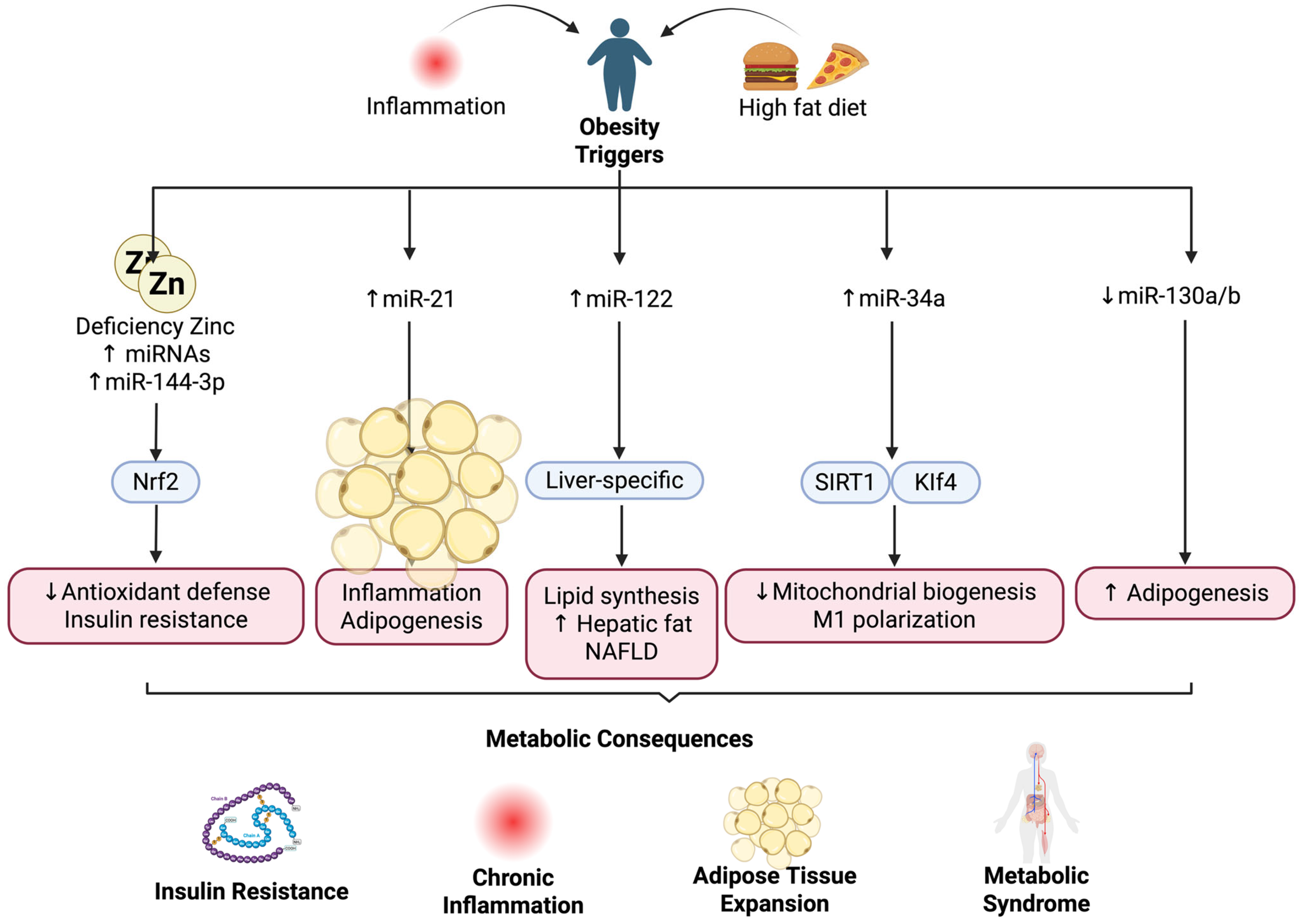
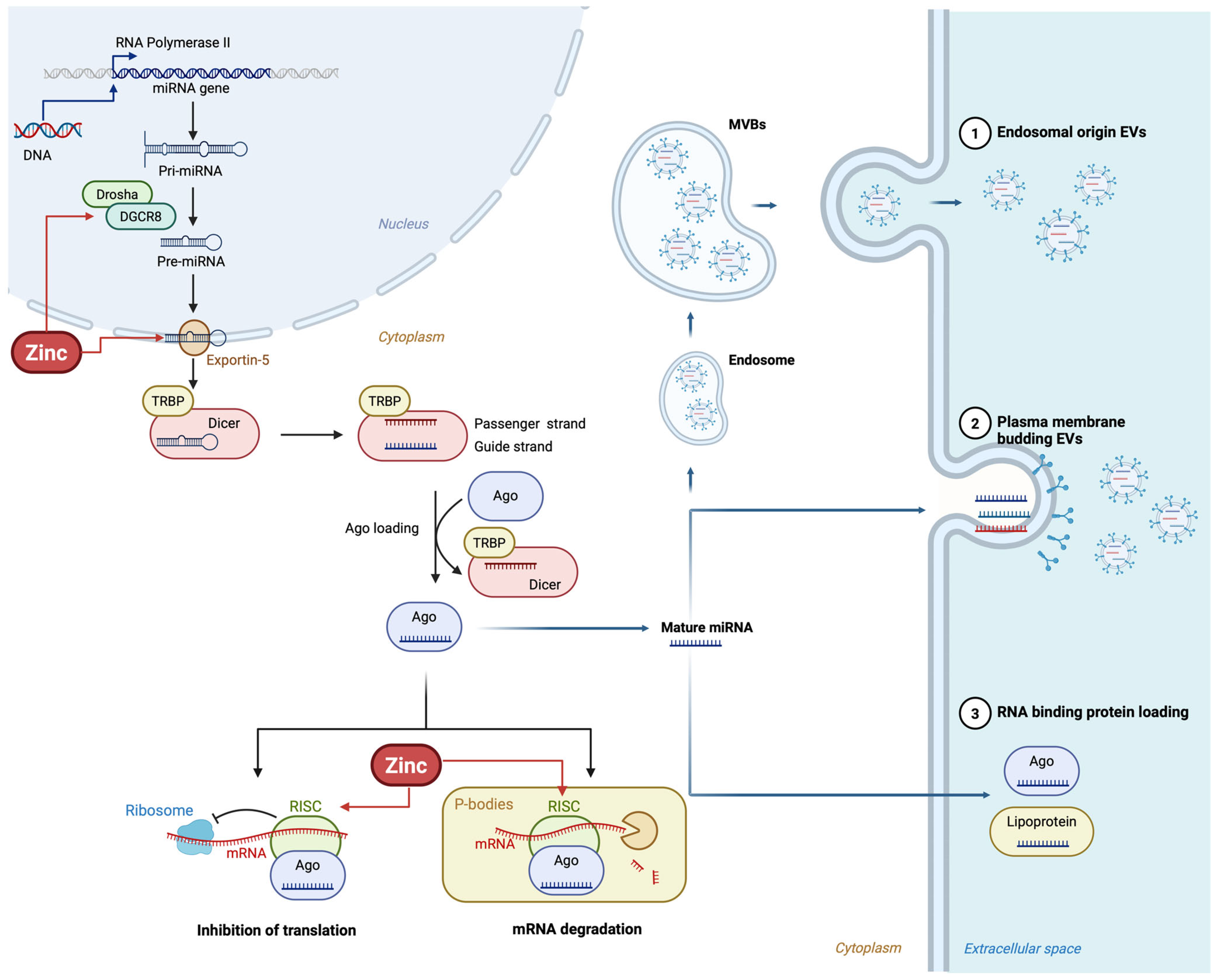
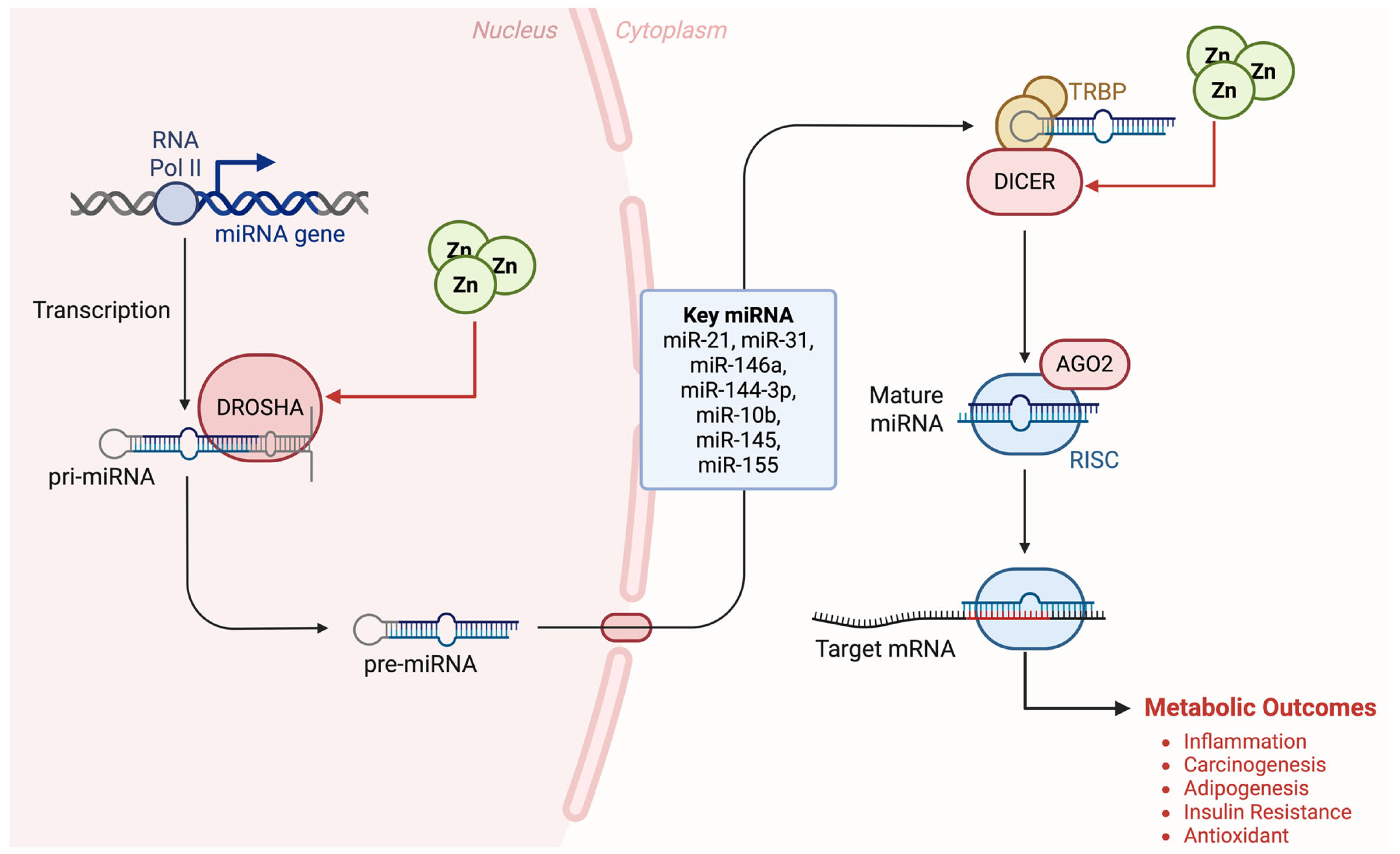
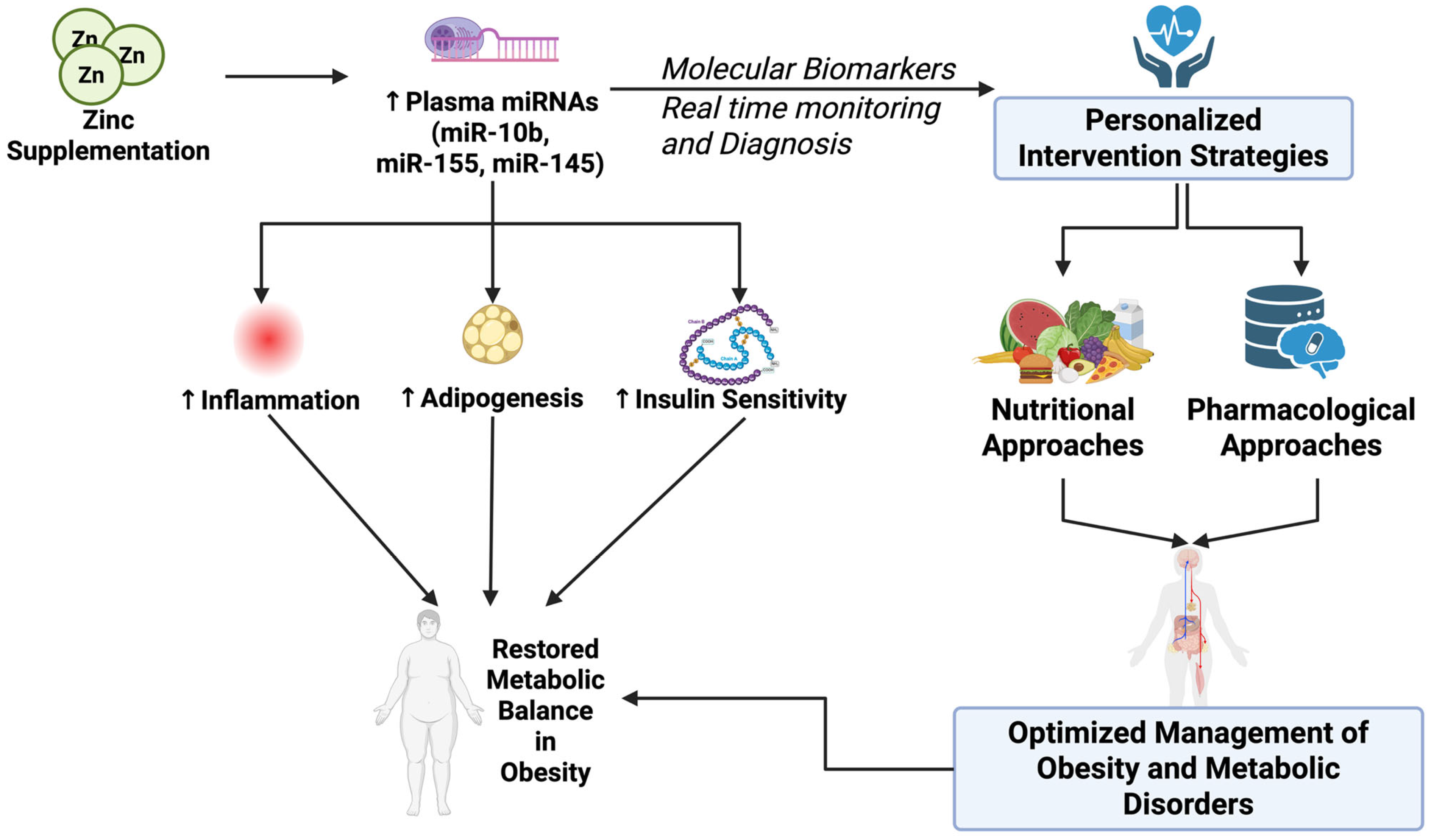
Disclaimer/Publisher’s Note: The statements, opinions and data contained in all publications are solely those of the individual author(s) and contributor(s) and not of MDPI and/or the editor(s). MDPI and/or the editor(s) disclaim responsibility for any injury to people or property resulting from any ideas, methods, instructions or products referred to in the content. |
© 2025 by the authors. Licensee MDPI, Basel, Switzerland. This article is an open access article distributed under the terms and conditions of the Creative Commons Attribution (CC BY) license (https://creativecommons.org/licenses/by/4.0/).
Share and Cite
Taslim, N.A.; Graciela, A.M.; Harbuwono, D.S.; Syauki, A.Y.; Anthony, A.N.; Ashari, N.; Aman, A.M.; Tjandrawinata, R.R.; Hardinsyah, H.; Bukhari, A.; et al. Zinc as a Modulator of miRNA Signaling in Obesity. Nutrients 2025, 17, 3375. https://doi.org/10.3390/nu17213375
Taslim NA, Graciela AM, Harbuwono DS, Syauki AY, Anthony AN, Ashari N, Aman AM, Tjandrawinata RR, Hardinsyah H, Bukhari A, et al. Zinc as a Modulator of miRNA Signaling in Obesity. Nutrients. 2025; 17(21):3375. https://doi.org/10.3390/nu17213375
Chicago/Turabian StyleTaslim, Nurpudji Astuti, Anne Maria Graciela, Dante Saksono Harbuwono, Andi Yasmin Syauki, Andrew Nehemia Anthony, Nur Ashari, Andi Makbul Aman, Raymond Rubianto Tjandrawinata, Hardinsyah Hardinsyah, Agussalim Bukhari, and et al. 2025. "Zinc as a Modulator of miRNA Signaling in Obesity" Nutrients 17, no. 21: 3375. https://doi.org/10.3390/nu17213375
APA StyleTaslim, N. A., Graciela, A. M., Harbuwono, D. S., Syauki, A. Y., Anthony, A. N., Ashari, N., Aman, A. M., Tjandrawinata, R. R., Hardinsyah, H., Bukhari, A., & Nurkolis, F. (2025). Zinc as a Modulator of miRNA Signaling in Obesity. Nutrients, 17(21), 3375. https://doi.org/10.3390/nu17213375







